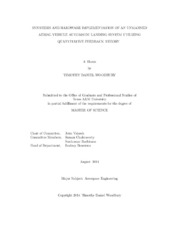| dc.contributor.advisor | Valasek, John | |
| dc.creator | Woodbury, Timothy Daniel | |
| dc.date.accessioned | 2015-02-05T17:25:30Z | |
| dc.date.available | 2016-08-01T05:30:01Z | |
| dc.date.created | 2014-08 | |
| dc.date.issued | 2014-07-08 | |
| dc.date.submitted | August 2014 | |
| dc.identifier.uri | https://hdl.handle.net/1969.1/153400 | |
| dc.description.abstract | Approach and landing are among the most difficult flight regimes for automatic control of fixed-wing aircraft. Additional challenges are introduced when working with unmanned aerial vehicles, such as modelling uncertainty and limited gust tolerance. This thesis develops linear discrete-time automatic landing controllers using Quantitative Feedback Theory to ensure control robustness and adequate disturbance rejection. Controllers are developed in simulation and evaluated in flight tests of the low cost Easy Star remote-controlled platform. System identification of the larger Pegasus unmanned aerial vehicle is performed to identify dynamic models from flight data. A full set of controllers are subsequently developed and evaluated in simulation for the Pegasus. The extensive simulation and experimental testing with the Easy Star will reduce the time required to implement the Pegasus control laws, and will reduce the associated risk by validating the core experimental software. It is concluded that the control synthesis process using Quantitative Feedback Theory provides robust controllers with generally adequate performance, based on simulation and hardware results. The Quantitative Feedback Theory framework provides a good method for synthesizing the inner-loop controllers and satisfying performance requirements, but in many of the cases considered here it is found to be impractical for the outer loop designs. The primary recommendations of this work are: perform additional verification flights on the Easy Star; repeat Pegasus system identification for a landing configuration before flight testing the control laws; design and implement a rudder control loop on the Pegasus for control of the vehicle after touchdown. | en |
| dc.format.mimetype | application/pdf | |
| dc.language.iso | en | |
| dc.subject | quantitative feedback theory | en |
| dc.subject | automatic landing | en |
| dc.subject | autolanding | en |
| dc.subject | qft | en |
| dc.subject | unmanned aerial vehicle | en |
| dc.subject | automatic control | en |
| dc.title | Synthesis and Hardware Implementation of an Unmanned Aerial Vehicle Automatic Landing System Utilizing Quantitative Feedback Theory | en |
| dc.type | Thesis | en |
| thesis.degree.department | Aerospace Engineering | en |
| thesis.degree.discipline | Aerospace Engineering | en |
| thesis.degree.grantor | Texas A & M University | en |
| thesis.degree.name | Master of Science | en |
| thesis.degree.level | Masters | en |
| dc.contributor.committeeMember | Chakravorty, Suman | |
| dc.contributor.committeeMember | Rathinam, Sivakumar | |
| dc.type.material | text | en |
| dc.date.updated | 2015-02-05T17:25:30Z | |
| local.embargo.terms | 2016-08-01 | |
| local.etdauthor.orcid | 0000-0002-4232-0331 | |


